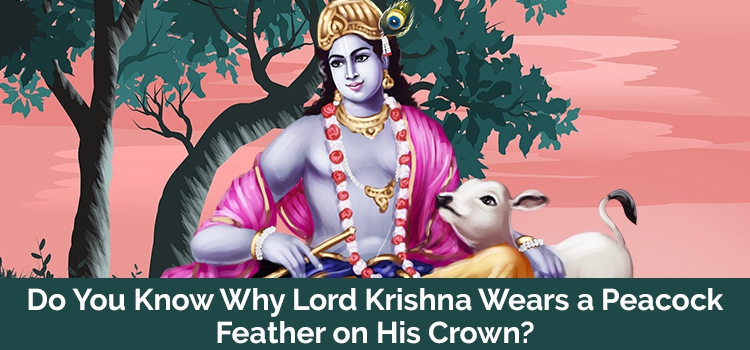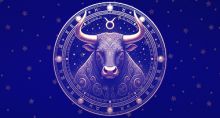Do you know why Lord Krishna is shown wearing a peacock feather on his crown?
Lord Krishna, a beloved deity of Hindus, is believed to have appeared on earth 5200 years ago. He is the most popular avatar or incarnation of Lord Vishnu, who took many avatars to rid the earth of evil. Though a curse ensured that Krishna could never become a king, he was a king-maker. If, as a child, he was a prankster, as an adult, he was a trickster who used his intelligence and guile to ensure the outcomes he wanted for his loved ones. For instance, in the Mahabaratha, he helped the Pandavas on many occasions to get the better of their feuding cousins, the Kauravas, in the epic battle of Kurukshetra.
As he had a dark complexion, he was named Krishna, which means ‘dark’. His discourse with the Pandava prince, Arjuna, on the battlefield of Kurukshetra, is called Bhagavad Gita. This sacred text is a divine guide that provides answers on life and living to confused mortals. Krishna is usually portrayed wearing a yellow loin-cloth, holding a flute to his lips, in standing posture, and with one leg crossed over the other at the ankles. He embodies Dharma or righteousness.

Though Krishna can be seen wearing many ornaments, one constant accessory seems to be a peacock feather that adorns his hair. Many people have wondered why he wears a peacock feather and whether it has some deeper meaning or significance. Why a peacock feather? Why not some other feather or ornament? Some stories have tried to explain the reason why Krishna wears a peacock feather. Here are some of them:
It indicates Krishna’s purity
Lord Krishna had eight main wives known as Ashtabharya as well as 16,000 junior wives with whom he had no conjugal relations. Krishna is an Askalitha Brahmacharya, or one who is forever a celibate. Despite his many marriages, he sought only the betterment of the world instead of sensual pleasures. Thus, Krishna is believed to be completely pure and devoid of any sensual desire. In India, peacocks are regarded as a symbol of purity. There is a mythological belief (though it is untrue) that peacocks do not engage in sex for reproduction. Instead, the peahen supposedly drinks the tears of the peacock and conceives. Hence, Krishna is as pure as a peacock, and that is the symbolism behind the feather, according to this story.
It has all the colors of Nature
It is said that a peacock feather has all the 7 colors of Nature. It has a bluish hue in the day, and it appears to be black at night. Ether, which surrounds us, also appears blue in the daytime and black at night. Krishna, also called the dark-skinned one, is depicted in both blue and black colors. Hence, Krishna wears the peacock feather, which contains the complete range of colors humans are made of. It also indicates that we are all part of the Supreme God. Krishna is God, so he is formless. But to humans, he is blue by day and black by night, making him similar to a peacock feather.
The peacock’s gift
Once, Krishna was playing the flute in the forest and dancing. His music was so melodious that the peacocks living in the forest began to dance to it. All the creatures that dwelt in the forest were totally spell-bound by the music. The peacocks kept dancing until they became tired, but Krishna continued to dance for many more days. Finally, when he ceased to dance, the spell was broken. But the peacocks were so happy and grateful that the king of peacocks went to Lord Krishna and asked him to accept his feathers as a token of gratitude. He then dropped some of his feathers on the ground, and Krishna accepted his offering. Since then, it is said that a peacock feather always adorns Lord Krishna’s hair.
It represents Maya
It is well-known that peacocks love rain and begin to dance when rain clouds gather. Seeing the sky filled with dark clouds seems to give them great joy. As Krishna is dark-skinned, he too resembles the dark rain clouds. When the peacocks see Krishna, they are reminded of rain. This fills them with happiness. His music also makes them dance, as it is very melodious. To express their gratitude, they give him their feathers which he gladly accepts and keeps in his hair.
These are some of the most popular stories about Krishna’s love for peacock feathers.
Some also believe that it serves to highlight the concept of Maya or Illusion. A person on Quora explains it using the phenomenon of structural coloration. According to them, Krishna’s main teaching hinges on the idea that our life and the entire Universe is nothing but a Maya or illusion created by him. He keeps telling the Pandava prince Arjuna, his friend and relative, that his presence lies beneath outwardly unrelated events as well as various living creatures in the Universe.
The peacock feathers illustrate Krishna’s Maya in a manner that we can easily grasp. The bird’s brilliant colors are not due to any pigments present in them but are the result of structural coloration. When light waves enter the keratin layers of varying thickness on the feathers, they undergo interference. This results in light wave patterns that create the brilliant colors that we see. But in reality, it is only deep brown pigment in the background of these keratin layers.
In this manner, Krishna wears an ingenious example of His own Maya in His crown to make us understand that the universe is only a diverse manifestation of one single Being. If we grasp this, we can also see that everything in life is Maya, and hence we will not fall prey to illusion and suffer on account of it. By wearing this idea in our mind, like Krishna wears the peacock feather in His crown, we too can live life the way Krishna wants us to – free of pain and sorrow.
Krishna’s birthday is celebrated as Krishna Jayanthi or Krishna Janmashtami. Mythology says that Krishna is the 8th avatar of Lord Vishnu. Krishna Jayanthi 2021/Krishna Janmashtami 2021 is on August 30.



















